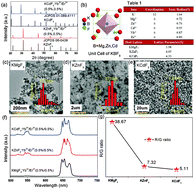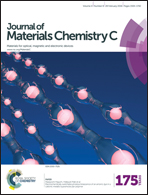Single-band red upconversion luminescence of Yb3+–Er3+via nonequivalent substitution in perovskite KMgF3 nanocrystals†
Abstract
Single-band red upconversion (UC) emission of Er3+ has been successfully achieved in Yb3+/Er3+ codoped KMgF3 nanocrystals via a nonequivalent substitution strategy, in which lanthanide ions probably aggregate, as evidenced by density functional theory calculations and upconversion dynamic processes. The aggregation of Yb3+/Er3+ would cause large cross-relaxation probabilities among the lanthanide ions when photo-excited, resulting in the disappearance of the green emission and the population of the red emitting level of Er3+. Interestingly, the single-band feature is independent of the dopant concentration and pump power. The possible UC mechanism is discussed in detail according to nanocrystal morphology, ion radii, lattice parameters and decay lifetime studies of the Yb3+–Er3+ doped analogous compounds (KMgF3, KZnF3 and KCdF3). It could be concluded that Yb3+/Er3+ ions tend to aggregate in KMgF3, resulting in the largest ratio of red to green UC emission. This research may give a perspective toward tuning the UC emission of lanthanide ions.


 Please wait while we load your content...
Please wait while we load your content...